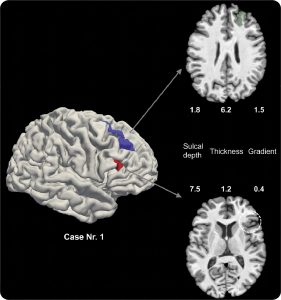Abstract
Objective: To detect automatically focal cortical dysplasia (FCD) type II in patients with extratemporal epilepsy initially diagnosed as MRI-negative on routine inspection of 1.5 and 3.0T scans.
Methods: We implemented an automated classifier relying on surface-based features of FCD morphology and intensity, taking advantage of their covariance. The method was tested on 19 patients (15 with histologically confirmed FCD) scanned at 3.0T, and cross-validated using a leave-one-out strategy. We assessed specificity in 24 healthy controls and 11 disease controls with temporal lobe epilepsy. Cross-dataset classification performance was evaluated in 20 healthy controls and 14 patients with histologically verified FCD examined at 1.5T.
Results: Sensitivity was 74%, with 100% specificity (i.e., no lesions detected in healthy or disease controls). In 50% of cases, a single cluster colocalized with the FCD lesion, while in the remaining cases a median of 1 extralesional cluster was found. Applying the classifier (trained on 3.0T data) to the 1.5T dataset yielded comparable performance (sensitivity 71%, specificity 95%).
Conclusion: In patients initially diagnosed as MRI-negative, our fully automated multivariate approach offered a substantial gain in sensitivity over standard radiologic assessment. The proposed method showed generalizability across cohorts, scanners, and field strengths. Machine learning may assist presurgical decision-making by facilitating hypothesis formulation about the epileptogenic zone.
Classification of evidence: This study provides Class II evidence that automated machine learning of MRI patterns accurately identifies FCD among patients with extratemporal epilepsy initially diagnosed as MRI-negative.

